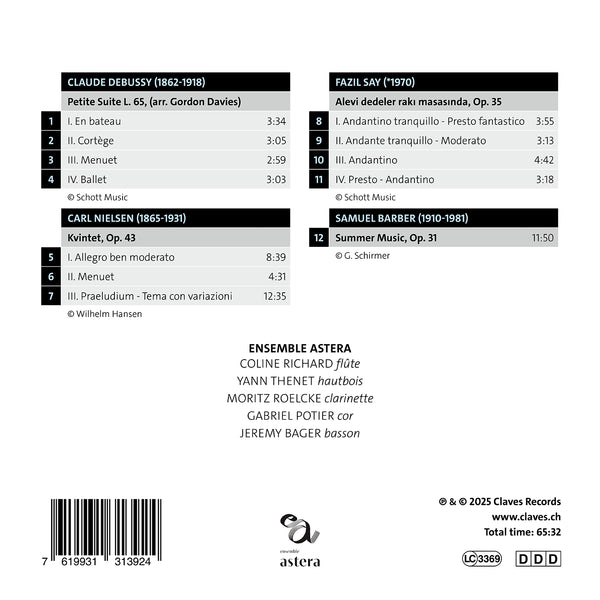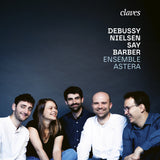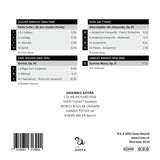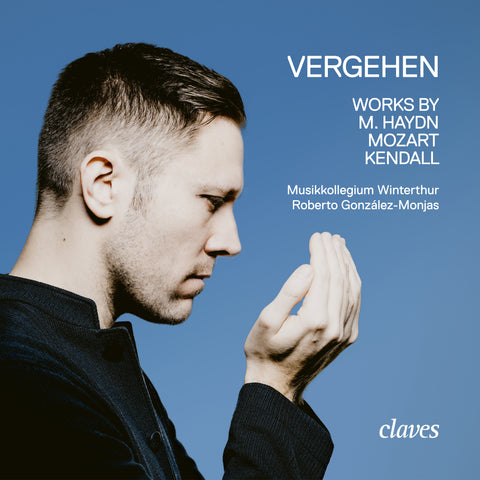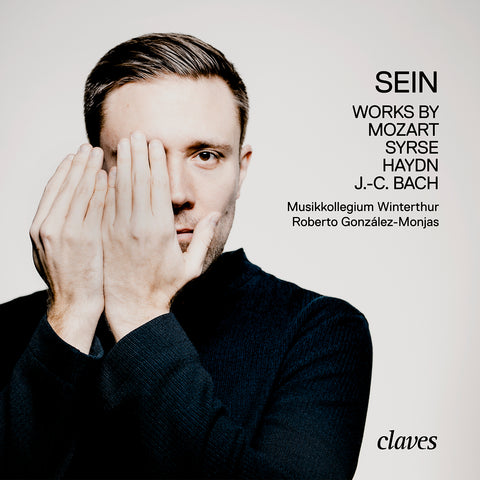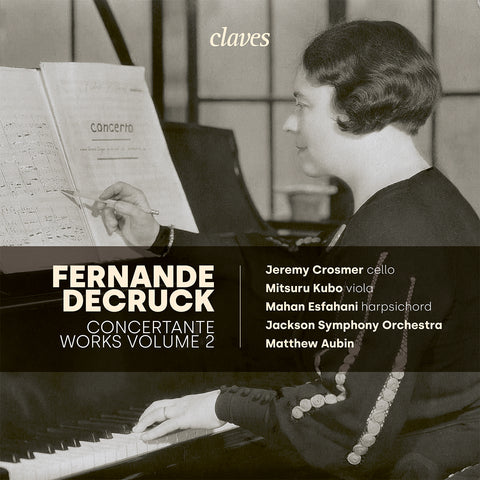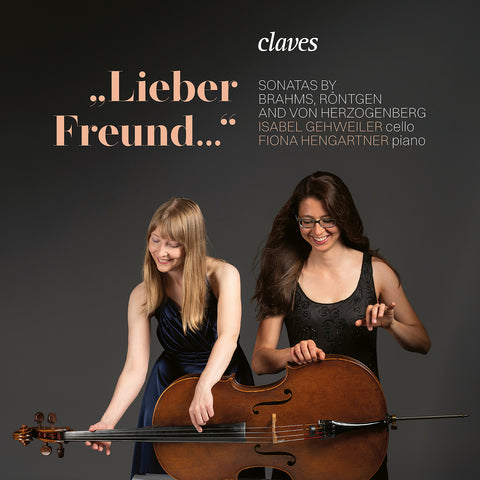(2025) Debussy, Nielsen, Say, Barber - Ensemble Astera
Category(ies): Brass Chamber Modern Rarities
Instrument(s): Bassoon Clarinet Flute Horn Oboe
Main Composer: Various composers (see collections)
Ensemble: Ensemble Astera
CD set: 1
Catalog N°:
CD 3139
Release: 30.05.2025
EAN/UPC: 7619931313924
(Will be sent some days before release date).
This album is now on repressing. Pre-order it at a special price now.
CHF 18.50
This album is no longer available on CD.
This album has not been released yet. Pre-order it from now.
CHF 18.50
This album is no longer available on CD.
CHF 18.50
VAT included for Switzerland & UE
Free shipping
This album is no longer available on CD.
VAT included for Switzerland & UE
Free shipping
This album is now on repressing. Pre-order it at a special price now.
CHF 18.50
This album is no longer available on CD.
This album has not been released yet.
Pre-order it at a special price now.
CHF 18.50
This album is no longer available on CD.
CHF 18.50
This album is no longer available on CD.
NEW: Purchases are now made in the currency of your country. Change country here or at checkout
DEBUSSY, NIELSEN, SAY, BARBER - ENSEMBLE ASTERA
Claude Debussy (1862–1918) always had a fondness for four-hand and two-piano writing, a quality that seems to underlie his orchestral compositions[1]. Perhaps this is precisely what makes his work for two pianos so suitable for transcription: the Petite Suite, with its rich sonorities, was arranged for orchestra by Henri Büsser and for wind quintet by Gordon Davies. Young Claude Debussy was recognised early on for his musical talent and was admitted to the Paris Conservatoire when he was only ten. He then broadened his artistic horizons during travels as an accompanist for Baroness von Meck. The Petite Suite is one of his early works. Published in 1889, it comprises four movements. The first, En Bateau (Sailing), recalls the barcarolle with its gentle rocking motion, first given by the clarinet and then the horn, surrounding the theme played by the flute. The central section becomes more animated before everything suddenly halts; time is suspended in a delicate transition that leads back to a varied reprise of the first theme. Le Cortège (Retinue), also in three sections, soars freely and light-heartedly before the return of the opening material. Debussy said that his Petite Suite “humbly seeks only to give pleasure”; this joy is perceived here, foreshadowing that of Fêtes (Festivals), the central movement of the Nocturnes for orchestra, premiered ten years later. Borrowing from Verlaine his melancholy and nostalgia for the “fêtes galantes” of the ancient régime, the Menuet is a delicate and diaphanous piece, where tonality gives way to modality.
Finally, a theme in a short-long rhythm, introduced by the horn, launches the joyous Ballet, reminiscent of Emmanuel Chabrier’s contemporaneous Suite pastorale. A waltz motif gradually establishes itself and becomes the counterpoint to the first theme in the concluding section. The joy of this music is infectious, spilling over into the programme’s other works.
Carl Nielsen’s Wind Quintet Op. 43 shares with Debussy’s work a pastoral, luminous character infused with a sense of humour. Coming from a modest background, Carl Nielsen (1865–1931) studied with Niels Gade at the Copenhagen Conservatory and received a scholarship that enabled him to study in Germany, France, and Italy. Initially a violinist and later a conductor at the Royal Danish Opera, he was appointed professor at the Copenhagen Conservatoire, eventually becoming its honorary director shortly before his death. His compositional style, which contributed to expanding tonality into an “evolving” tonality, is often compared to his contemporary Jean Sibelius (1865–1957)[2]. However, it is primarily the composer’s admiration for Haydn and Mozart that shines through in this work. The idea of a wind quintet was sparked during a phone call with his friend Christian Christiansen, who was then rehearsing Mozart’s Sinfonia Concertante for oboe, clarinet, horn, and bassoon K. 297b. Enthralled by what he heard, Nielsen asked to attend the rehearsal. “Nielsen knew us all,” recounts oboist Sven Felumb. “We played Mozart’s Koncertantes Quartet [sic], where the final movement is an incomparable series of variations. He became immensely happy. We drank some tea (or was it beer?). He talked and talked about Mozart, wind players etc. But then he suddenly became quiet. So he gave us all a kind look and promised to compose a wind quintet if we promised to perform it. He confided to us that he was very captivated by the way we played our instruments. He referred to the combination of our different personalities and the characteristics of our instruments. He said that the quintet would contain variations, where he would do his best to reflect every personality[3].” And so he did. The first two movements are highly reminiscent of Mozart, starting with an Allegro ben moderato in sonata form, whose freshness and lightness evoke nature, featuring deep timbres answering the flute’s airy notes while repeated motifs of repeated notes bouncing from one instrument to another seem to evoke birdsong. The Minuet pursues this lightness with a spirit and humour strongly indebted to Haydn. Finally, the third movement begins with a solemn Praeludium, which, in contrast to the preceding movements, establishes an almost unsettling atmosphere before the composer’s chorale gradually restores a sense of lightness through a set of eleven variations. As Nielsen had announced, these variations highlight not only the personality of each instrument but also of each performer, like many knowing winks. Following this quintet, Nielsen planned moreover to compose a concerto for each member of the Copenhagen Wind Quintet, a project he only partially completed[4]. The premiere was hailed by critics as a true success for a bright and sunny work[5].
The quintet Alevi dedeler rakı masasında, Op. 35 (Alevi Dedes at the Raki Table), was written in 2011 by Turkish pianist and composer Fazıl Say (b. 1970). Structured in four movements, the piece depicts the discussion of five spiritual masters, the Alevi Dedes: “They’re talking about everything, life, humans, world, religion. I’ve composed a piece of work based on a true story I was told. Here, each instrument represents one of the dedes. The first two consist of rather amusing talk, the third includes Âşık Veysel’s The Day and Night, and the fourth part towards the final is a bit more abstract[6]”. The first movement introduces a recurring unison refrain, which reappears throughout the piece, soon supported by a light and dance-like rhythm, interspersed with moments of tension. The second movement adds a touch of humour and irony. Darker accents signal a shift in tone in the third movement, before the final movement returns to the lightness of the opening, infused with a sense of magic and “abstraction”. It leaves the listener to dream pensively in front of the setting sun.
Constructed in a single movement, Samuel Barber’s (1910–1981) Summer Music Op. 31 was composed in 1953 for the Detroit Chamber Music Society. It was initially conceived for a septet of wind and string instruments but became a quintet and premiered on 20th March 1956. The piece is structured in different sections that echo one another and highlight the timbral qualities of each instrument. The first theme, carried by the oboe, creates a tender and nostalgic atmosphere before giving way to a faster, humorous passage that leads to a motoric section alternating between eight and seven semiquaver measures. Eventually, the melancholic oboe melody returns. A second section presents the flute’s song over murmuring clarinets and bassoons before other voices take up the melody, culminating in a festive section before the return of the opening’s nostalgia.
Bénédicte Gandois
Translated from French by Michelle Bulloch - Musitext
___________________________________________
[1] François Lesure, « Debussy et les transcriptions », in Revue belge de Musicologie, 1998, Vol. 52, p. 85.
[2] Source : François-René Tranchefort, « Carl Nielsen », in La Musique de chambre, Fayard, 1989, p. 669.
[3] Anecdote reported by Karen R. Moses, Nielsen, Hindemith and Schoenberg: Foundations of the Twentieth-Century Wind Quintet, Doctoral Thesis, Washington D. C., 2015, p. 21.
[4] He indeed completed a Flute Concerto, premiered in 1926, and a Clarinet Concerto, premiered in 1928, to which one can add two Fantasies for oboe and orchestra.
[5] “Carl Nielsen’s quintet is a notable contribution to the wind chamber repertory, and one of his sunniest compositions”, John Horton, in The Musical Times, vol. 110, nr. 1514, April 1969, p. 387.
[6] Source: Presentation of the quintet by the composer, available on youtube.com.
ENSEMBLE ASTERA
The woodwind quintet Ensemble Astera, was the first prize winner of the Carl Nielsen International Chamber Music Competition of 2023.
Since the founding of the Ensemble in 2019, the musicians of the Ensemble Astera have been united by friendship and a common passion for chamber music. They are keen to communicate their shared musical vision, namely the blending of the diverse sounds and timbres of their five wind instruments in search for unity and the broadest artistic dimension.
The ensemble members’ experiences with major international orchestras have enhanced their cohesion, distinctive sound, and musical affinity with the wind quintet. This Franco-Swiss Ensemble offers a refreshing perspective on the classical music scene. The musicians are driven by an insatiable enthusiasm, investing their energy towards thoughtful and committed performances, whilst making the most of their ensemble’s many sound possibilities.
The Ensemble’s artistic dynamism is also characterised by its approach to the contemporary repertoire, and its strong desire to bring innovation to concerts halls. This was acknowledge by the winning of the prize for best performance of the commissioned work at the 2023 Nielsen competition.
The Ensemble Astera regularly performs for festivals and music seasons across Europe, such as Lavaux Classic, Aix-en-Provence Easter Festival, Davos Festival, Radio France Festival, Rencontres Musicales d’Evian and the Murten Classics Festival among others. The Ensemble has also been heard on France Musique, Radio Télévision Suisse and Danish Radio.
Since 2023, the Ensemble Astera is Artist in residence at the Fondation Singer-Polignac in Paris.
ARTISTS
Coline Richard, flute
Yann Thenet, oboe
Moritz Roelcke, clarinet
Gabriel Potier, horn
Jeremy Bager, bassoon
(2025) Debussy, Nielsen, Say, Barber - Ensemble Astera - CD 3139
Claude Debussy (1862–1918) always had a fondness for four-hand and two-piano writing, a quality that seems to underlie his orchestral compositions[1]. Perhaps this is precisely what makes his work for two pianos so suitable for transcription: the Petite Suite, with its rich sonorities, was arranged for orchestra by Henri Büsser and for wind quintet by Gordon Davies. Young Claude Debussy was recognised early on for his musical talent and was admitted to the Paris Conservatoire when he was only ten. He then broadened his artistic horizons during travels as an accompanist for Baroness von Meck. The Petite Suite is one of his early works. Published in 1889, it comprises four movements. The first, En Bateau (Sailing), recalls the barcarolle with its gentle rocking motion, first given by the clarinet and then the horn, surrounding the theme played by the flute. The central section becomes more animated before everything suddenly halts; time is suspended in a delicate transition that leads back to a varied reprise of the first theme. Le Cortège (Retinue), also in three sections, soars freely and light-heartedly before the return of the opening material. Debussy said that his Petite Suite “humbly seeks only to give pleasure”; this joy is perceived here, foreshadowing that of Fêtes (Festivals), the central movement of the Nocturnes for orchestra, premiered ten years later. Borrowing from Verlaine his melancholy and nostalgia for the “fêtes galantes” of the ancient régime, the Menuet is a delicate and diaphanous piece, where tonality gives way to modality.
Finally, a theme in a short-long rhythm, introduced by the horn, launches the joyous Ballet, reminiscent of Emmanuel Chabrier’s contemporaneous Suite pastorale. A waltz motif gradually establishes itself and becomes the counterpoint to the first theme in the concluding section. The joy of this music is infectious, spilling over into the programme’s other works.
Carl Nielsen’s Wind Quintet Op. 43 shares with Debussy’s work a pastoral, luminous character infused with a sense of humour. Coming from a modest background, Carl Nielsen (1865–1931) studied with Niels Gade at the Copenhagen Conservatory and received a scholarship that enabled him to study in Germany, France, and Italy. Initially a violinist and later a conductor at the Royal Danish Opera, he was appointed professor at the Copenhagen Conservatoire, eventually becoming its honorary director shortly before his death. His compositional style, which contributed to expanding tonality into an “evolving” tonality, is often compared to his contemporary Jean Sibelius (1865–1957)[2]. However, it is primarily the composer’s admiration for Haydn and Mozart that shines through in this work. The idea of a wind quintet was sparked during a phone call with his friend Christian Christiansen, who was then rehearsing Mozart’s Sinfonia Concertante for oboe, clarinet, horn, and bassoon K. 297b. Enthralled by what he heard, Nielsen asked to attend the rehearsal. “Nielsen knew us all,” recounts oboist Sven Felumb. “We played Mozart’s Koncertantes Quartet [sic], where the final movement is an incomparable series of variations. He became immensely happy. We drank some tea (or was it beer?). He talked and talked about Mozart, wind players etc. But then he suddenly became quiet. So he gave us all a kind look and promised to compose a wind quintet if we promised to perform it. He confided to us that he was very captivated by the way we played our instruments. He referred to the combination of our different personalities and the characteristics of our instruments. He said that the quintet would contain variations, where he would do his best to reflect every personality[3].” And so he did. The first two movements are highly reminiscent of Mozart, starting with an Allegro ben moderato in sonata form, whose freshness and lightness evoke nature, featuring deep timbres answering the flute’s airy notes while repeated motifs of repeated notes bouncing from one instrument to another seem to evoke birdsong. The Minuet pursues this lightness with a spirit and humour strongly indebted to Haydn. Finally, the third movement begins with a solemn Praeludium, which, in contrast to the preceding movements, establishes an almost unsettling atmosphere before the composer’s chorale gradually restores a sense of lightness through a set of eleven variations. As Nielsen had announced, these variations highlight not only the personality of each instrument but also of each performer, like many knowing winks. Following this quintet, Nielsen planned moreover to compose a concerto for each member of the Copenhagen Wind Quintet, a project he only partially completed[4]. The premiere was hailed by critics as a true success for a bright and sunny work[5].
The quintet Alevi dedeler rakı masasında, Op. 35 (Alevi Dedes at the Raki Table), was written in 2011 by Turkish pianist and composer Fazıl Say (b. 1970). Structured in four movements, the piece depicts the discussion of five spiritual masters, the Alevi Dedes: “They’re talking about everything, life, humans, world, religion. I’ve composed a piece of work based on a true story I was told. Here, each instrument represents one of the dedes. The first two consist of rather amusing talk, the third includes Âşık Veysel’s The Day and Night, and the fourth part towards the final is a bit more abstract[6]”. The first movement introduces a recurring unison refrain, which reappears throughout the piece, soon supported by a light and dance-like rhythm, interspersed with moments of tension. The second movement adds a touch of humour and irony. Darker accents signal a shift in tone in the third movement, before the final movement returns to the lightness of the opening, infused with a sense of magic and “abstraction”. It leaves the listener to dream pensively in front of the setting sun.
Constructed in a single movement, Samuel Barber’s (1910–1981) Summer Music Op. 31 was composed in 1953 for the Detroit Chamber Music Society. It was initially conceived for a septet of wind and string instruments but became a quintet and premiered on 20th March 1956. The piece is structured in different sections that echo one another and highlight the timbral qualities of each instrument. The first theme, carried by the oboe, creates a tender and nostalgic atmosphere before giving way to a faster, humorous passage that leads to a motoric section alternating between eight and seven semiquaver measures. Eventually, the melancholic oboe melody returns. A second section presents the flute’s song over murmuring clarinets and bassoons before other voices take up the melody, culminating in a festive section before the return of the opening’s nostalgia.
Bénédicte Gandois
Translated from French by Michelle Bulloch - Musitext
___________________________________________
[1] François Lesure, « Debussy et les transcriptions », in Revue belge de Musicologie, 1998, Vol. 52, p. 85.
[2] Source : François-René Tranchefort, « Carl Nielsen », in La Musique de chambre, Fayard, 1989, p. 669.
[3] Anecdote reported by Karen R. Moses, Nielsen, Hindemith and Schoenberg: Foundations of the Twentieth-Century Wind Quintet, Doctoral Thesis, Washington D. C., 2015, p. 21.
[4] He indeed completed a Flute Concerto, premiered in 1926, and a Clarinet Concerto, premiered in 1928, to which one can add two Fantasies for oboe and orchestra.
[5] “Carl Nielsen’s quintet is a notable contribution to the wind chamber repertory, and one of his sunniest compositions”, John Horton, in The Musical Times, vol. 110, nr. 1514, April 1969, p. 387.
[6] Source: Presentation of the quintet by the composer, available on youtube.com.
ENSEMBLE ASTERA
The woodwind quintet Ensemble Astera, was the first prize winner of the Carl Nielsen International Chamber Music Competition of 2023.
Since the founding of the Ensemble in 2019, the musicians of the Ensemble Astera have been united by friendship and a common passion for chamber music. They are keen to communicate their shared musical vision, namely the blending of the diverse sounds and timbres of their five wind instruments in search for unity and the broadest artistic dimension.
The ensemble members’ experiences with major international orchestras have enhanced their cohesion, distinctive sound, and musical affinity with the wind quintet. This Franco-Swiss Ensemble offers a refreshing perspective on the classical music scene. The musicians are driven by an insatiable enthusiasm, investing their energy towards thoughtful and committed performances, whilst making the most of their ensemble’s many sound possibilities.
The Ensemble’s artistic dynamism is also characterised by its approach to the contemporary repertoire, and its strong desire to bring innovation to concerts halls. This was acknowledge by the winning of the prize for best performance of the commissioned work at the 2023 Nielsen competition.
The Ensemble Astera regularly performs for festivals and music seasons across Europe, such as Lavaux Classic, Aix-en-Provence Easter Festival, Davos Festival, Radio France Festival, Rencontres Musicales d’Evian and the Murten Classics Festival among others. The Ensemble has also been heard on France Musique, Radio Télévision Suisse and Danish Radio.
Since 2023, the Ensemble Astera is Artist in residence at the Fondation Singer-Polignac in Paris.
ARTISTS
Coline Richard, flute
Yann Thenet, oboe
Moritz Roelcke, clarinet
Gabriel Potier, horn
Jeremy Bager, bassoon
Return to the album | Read the booklet | Composer(s): Various Composers | Main Artist: Ensemble Astera
Brass
Carl Nielsen (1865-1931)
Chamber
Clarinet
Claude Debussy (1862-1918)
Coline Richard - Flute
Ensemble Astera
Fazıl Say (*1970)
Flute
Gabriel Potier - Horn
High-resolution audio - Studio master quality
Horn
In stock
Jeremy Bager - Bassoon
Modern
Moritz Roelcke - Clarinet
Oboe
Rarities
Samuel Barber (1910-1981)
Soon
Various composers
Yann Thenet - Oboe
Brass
Carl Nielsen (1865-1931)
Chamber
Clarinet
Claude Debussy (1862-1918)
Coline Richard - Flute
Ensemble Astera
Fazıl Say (*1970)
Flute
Gabriel Potier - Horn
High-resolution audio - Studio master quality
Horn
In stock
Jeremy Bager - Bassoon
Modern
Moritz Roelcke - Clarinet
Oboe
Rarities
Samuel Barber (1910-1981)
Soon
Various composers
Yann Thenet - Oboe


